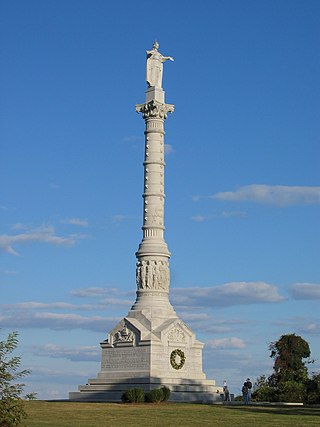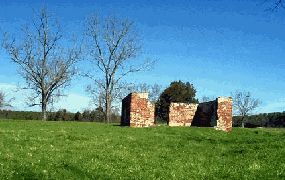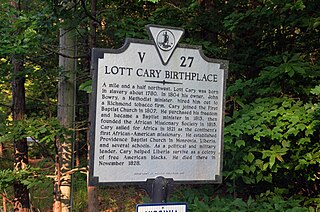
Berkeley Plantation, one of the first plantations in America, comprises about 1,000 acres (400 ha) on the banks of the James River on State Route 5 in Charles City County, Virginia. Berkeley Plantation was originally called Berkeley Hundred, named after the Berkeley Company of England. In 1726, it became the ancestral home of the Harrison family of Virginia, after Benjamin Harrison IV located there and built one of the first three-story brick mansions in Virginia. It is the home to two presidents of the United States: William Henry Harrison, and his grandson Benjamin Harrison. It is now a museum property, open to the public.

Colonial National Historical Park is a large national historical park located in the Hampton Roads region of Virginia operated by the National Park Service. It protects and interprets several sites relating to the Colony of Virginia and the history of the United States more broadly. These range from the site of the first English settlement at Jamestown, to the battlefields of Yorktown where the British Army was defeated in the American Revolutionary War. Over 3 million people visit the park each year.

Sir William Berkeley was an English colonial administrator who served as the governor of Virginia from 1660 to 1677. One of the Lords Proprietors of the Province of Carolina, as governor of Virginia he implemented policies that bred dissent among the colonists and sparked Bacon's Rebellion. A favourite of King Charles I, the king first granted him the governorship in 1642. Berkeley was unseated following the execution of Charles I, but his governorship was restored by King Charles II in 1660.

Bruton Parish Church is located in the restored area of Colonial Williamsburg in Williamsburg, Virginia, United States. It was established in 1674 by the consolidation of two previous parishes in the Virginia Colony, and remains an active Episcopal parish. The building, constructed 1711–15, was designated a National Historic Landmark in 1970 as a well-preserved early example of colonial religious architecture.

Green Spring Plantation in James City County about five miles (8.0 km) west of Williamsburg, was the 17th century plantation of one of the most unpopular governors of Colonial Virginia in North America, Sir William Berkeley, and his wife, Frances Culpeper Berkeley.
Richneck Plantation was located on the Virginia Peninsula on the northern shore of the James River between Hampton Roads and Jamestown in the English colony of Virginia. The Richneck manor house's foundation was discovered during construction of the George J. McIntosh elementary school, and became an archeological dig, then listed on the National Register of Historic Places.

Elsing Green Plantation, a National Historic Landmark and wildlife refuge, rests upon nearly 3,000 acres (1,200 ha) along the Pamunkey River in King William County, Virginia, a rural county on the western end of the state's middle peninsula, approximately 33 miles (53 km) northeast of the Richmond. The 18th-century plantation, now owned by the Lafferty family, has been in continuous operation for more than 300 years. In addition to the plantation house, dependency buildings and cultivated land, Elsing Green includes 2,454 acres (993 ha) of surrounding farmland, forest and marsh land. Elsing Green has been on the Virginia Landmarks Register and the National Register of Historic Places since 1969, and received formal National Historic Landmark status in 1971.
Sir John Harvey was a Crown Governor of Virginia. He was appointed to the position on 26 March 1628 by Charles I of England. In 1635 he was suspended and impeached by the Council of Virginia, and he returned to England. He claimed a conspiracy to change the charter of the colony by John Wolstenholme was the reason for the failures of his administration.
Samuel Stephens (1629–1669) was the Governor of the Albemarle colony from 1667 until his death in late 1669. He was appointed by the Lords Proprietor to succeed William Drummond.

Pocahontas Island is a peninsula in Petersburg, Virginia once on the opposite side of the Appomattox River from Petersburg. Since 1915 a new channel for the river separated it from Chesterfield County and the former channel no longer separates it from the city. Once a warehouse and wharf-filled urban landscape initially platted in 1749, the island was devastated by a 1993 tornado before citizen involvement caused creation of the Pocahontas Island Historic District, which in 2006 achieved listing on the National Register of Historic Places (NRHP) as a historic district because of its significance in African-American history and for its prehistoric indigenous archeological assets.

Lott Cary Birth Site, also known as the Lott Cary House, is a historic home located near Charles City, Charles City County, Virginia. The modest wooden frame plantation house was built in the late-18th century, and consists of a 1+1⁄2-story, three bay, original main house, extended by the later addition of one-story wings. Little of the original fabric remains.

Mayfield Cottage is a historic plantation house located near the grounds of Central State Hospital near Petersburg, Dinwiddie County, Virginia. Believed to be the oldest existing brick house in Dinwiddie County, it was built around 1750 and the residence of Robert Ruffin until 1769, when he moved to King William County. From 1885, the property was used by the hospital for its headquarters. The house remained part of the hospital complex until 1969. It was moved from its original site about .5 miles (0.80 km) to the southeast of the present site in 1969.

Rosegill is a historic plantation house and farm complex located near Urbanna, Middlesex County, Virginia. It has been listed on the National Register of Historic Places since 1973.

Denbigh Plantation Site, also known as Mathews Manor, is a historic archaeological site located at Newport News, Virginia.
Leesylvania was a plantation and historic home in Prince William County, Virginia, now part of Leesylvania State Park. During the 18th century, it was the home of Henry Lee II, his family and numerous slaves, and known for its productive land and especially the quality of its tobacco. Lee's sons Henry "Light-Horse Harry" Lee, Richard Bland Lee and Charles Lee, held prominent positions in Virginia during the American Revolutionary War and early federal government.
Cole Digges (1691-1744) was a Virginia merchant, planter and politician who helped establish Yorktown, Virginia, and served more than two decades on the Virginia Governor's Council after representing Warwick County in the House of Burgesses.
William Cole (1691-1729) was a planter and politician who represented Warwick County in the House of Burgesses (1715-1728).
William Cole was a lawyer, planter and government official in the Colony of Virginia. He served decades on the Virginia Governor's Council and briefly as the Colony's Secretary of State. He aided Governor William Berkeley during Bacon's Rebellion, but fell out of governmental favor when a letter he had written to former Governor Francis Howard, baron Howard of Effingham, was revealed to Lieutenant Governor Francis Nicholson.













